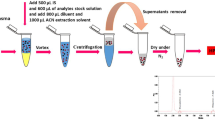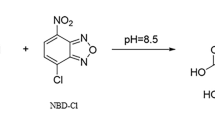Abstract
Purpose. A comparison of a previously reported indirect (precolumn derivatization) assay for ketorolac (KT) and a new direct method described here was made to establish the conditions under which KT may undergo racemization and to explain the observed discrepancies in the pharmacokinetics of KT reported in the literature.
Methods. A previously reported pre-column derivatization method and a new direct method were employed to determine the effect of pH and ionic strength on racemization. Using the conditions where no racemization occurred, the pharmacokinetics in humans and rats, and protein binding of KT enantiomers were determined.
Results. Under the chromatographic conditions employed for the direct assay, no racemization was observed. Under high pH and ionic strength, however, both methods resulted in KT racemization. The indirect method resulted in rapid and complete racemization due to the strong basic conditions required for derivatization. In both humans and rats, the pharmacokinetics of racemic KT were stereoselective with the R enantiomer being predominant (AUC S/R: humans, 0.26; Rats: 0.45). This is likely due to more extensive plasma protein binding of S than its antipode (unbound S/R: 1.35).
Conclusions. The discrepancies in the literature may be explained by rapid racemization of KT that occurs during sample preparation for the pre-column derivatization method. Considerations should be given to the possibility of racemization during the assay development and validation.
Similar content being viewed by others
REFERENCES
Jamali, F., Mehvar R, Pasutto F.M. Enantioselective aspects of drug action and disposition: Therapeutic pitfalls J. Pharm. Sci. 78:695–715, 1989
Brocks, DR, Jamali F. Clinical pharmacokinetics of ketorolac tromethamine. Clin. Pharmacokinet. 23:415–27 (1992)
Jamali, F., Pasutto, F.M., Lemko, C. HPLC of ketorolac enantiomers and application to pharmacokinetics in the rat. Journal of liquid chromatography 12:1835–1850 (1989)
Hayball, P.J., Tamblyn, J.G., Holden, Y., Wrobel, J. Stereoselective analysis of ketorolac in human plasma by High performance liquid Chromatography. Chirality 5:31–35 (1993)
Hayball, P.J., Wrobel, J., Tamblyn, J.G., Nation, R.L. The pharmacokinetics of ketoroloac enantiomers following intramuscular administration of the racemate. Brit. J. Clin. Pharmacol. 37:75–78 (1994)
Mroszczak, E., Combs, D., Tsina, I., Tam, Y., Massey, I., Chaplin, M., Yee, J. Pharmacokinetics of (−) S and R (+) enantiomers of ketorolac (K) in humans following administration of racemic ketorolac tromethamine (KT) Clin. Pharmacol. Ther. 49:126 (Abstract PI-13) (1991)
Diaz-Perez, Maria, J., Chen, John C., Aubry, Anne-Francoise., Wainer, Irving W. The direct determination of ketorolac and parahydroxyketorolac in plasma and urine using enantioselective liquid chromatography on a human serum albumin based chiral stationary phase. Chirality 6:283–289 (1994)
Testa, B., Carrupt, P., Gal, J. The so-called “interconversion of stereoisomeric drugs”: An attempt at clarification. Chirality 5:105–11 (1993)
Wright, M.R., Jamali, F. Limited extent of stereochemical conversion of chiral non-steroidal anti-inflammatory drugs induced by derivitization methods employing ethyl chloroformate. J. Chrom. 6:59–65 (1993)
Hayball, P.J., Holman, J.W., Nation, R.L., Massey-Westrop, R.A., Hamon, D.P.G. Marked enantioselective protein binding in humans of ketorolac in-vitro: Elucidation of enantiomer unbound fractions following facile synthesis and direct chiral HPLC resolution of tritium labeled ketorolac. Chirality, 6:642–648 (1994)
Jamali, F., Mehvar, R., Lemko, C., Eradiri, O. Application of a stereospecific high-performance liquid chromatography assay to a pharmacokinetic study of etodolac enantiomers in humans. J. Pharm. Sci. 77:963–966, 1985.
Author information
Authors and Affiliations
Rights and permissions
About this article
Cite this article
Vakily, M., Corrigan, B. & Jamali, F. The Problem of Racemization in the Stereospecific Assay and Pharmacokinetic Evaluation of Ketorolac in Human and Rats. Pharm Res 12, 1652–1657 (1995). https://doi.org/10.1023/A:1016245101389
Issue Date:
DOI: https://doi.org/10.1023/A:1016245101389




